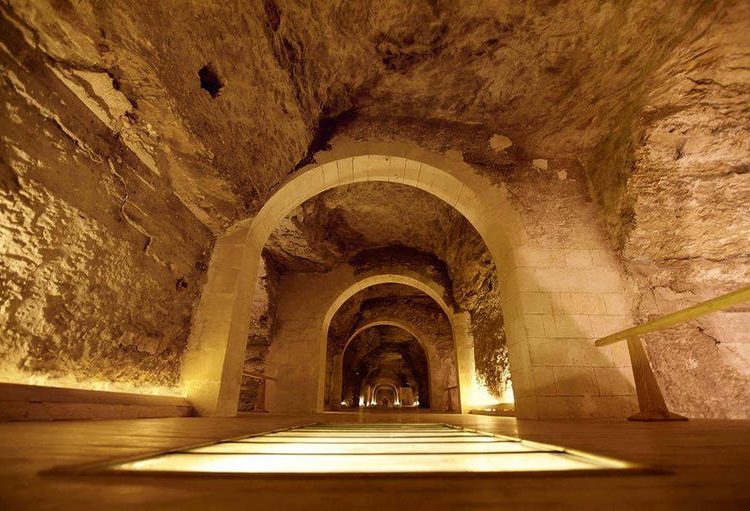If you love ancient mysteries, you will be amazed by the Serapeum at Saqqara. This is a colossal underground structure that contains the tombs of the sacred Apis bulls.
The Apis bulls were sacred animals in ancient Egypt, associated with the god Ptah, the creator and patron of craftsmen. They were believed to be manifestations of his power and wisdom, and were revered as oracles and protectors of the pharaoh and the people.
The Apis bulls were selected from the herd based on specific markings, such as a white triangle on the forehead, symbolising the divine light, a vulture wing on the back, representing the goddess Nekhbet, and a scarab under the tongue, signifying rebirth.
These markings were believed to indicate that the bull was chosen by Ptah himself and possessed his spirit.
They were kept in a special temple at Memphis, the cult centre of Ptah, where they received royal treatment and offerings from pilgrims. When they died, they were mummified and buried in elaborate tombs, known as the Serapeum, where they were worshipped as intercessors between humans and gods.
The Serapeum was discovered in 1850 by French archaeologist Auguste Mariette who came to Egypt to search for Coptic manuscripts.
“The discovery of the Serapeum has provided valuable information about the worship of Apis bulls and the religious rituals associated with their burial,” Egyptologist Mostafa Waziry said.
“Only one bull was chosen until its death, mummification, and burial, and then another bull was chosen that had other specifications and characteristics that distinguished it from other bulls,” he added in his study on ‘Serapeum’.
“About 64 burials of the Apis bulls were buried in the Serapeum,” he said.
The first burial of the Apis bull began in the 18th Dynasty (1550/1549 to 1292 BC), when Mariette found a burial from the era of King Amenhotep III.
“In the 19th Dynasty (1292 BC to 1189 BC), the first Serapeum tunnel was dug, which was cleaned again in 1982, where an important group of votive plaques were revealed. In addition, some hieratic writings on the walls of the corridor are also noticed. The holy bulls were buried inside wooden coffins,” Waziry added.
The Serapeum consists of a long corridor with several side chambers, each containing a massive granite sarcophagus that weighs up to 80 tonnes. The sarcophagi are inscribed with hieroglyphs and reliefs that depict the life and death of the Apis bulls.
In the Late Period of ancient Egypt until the beginning of the Roman era, the current form of Serapeum was reshaped.
“It is a tunnel about 150 metres long, three metres wide, and an average height of five metres. On both sides of the corridor are special graves for the burial of sacred bulls with a vaulted ceiling in an alternating manner,” he wrote.
Their cult lasted for over three thousand years, from the First Dynasty to the Roman period, and influenced other cultures such as the Greeks and the Persians, who adopted similar worship of sacred bulls.
They influenced other cultures by spreading their symbolism of fertility, rebirth, balance, and eternity. For example, the Greeks identified Apis with their god Zeus and created a new deity called Serapis, who combined aspects of both. The Persians also respected the Apis bull and allowed its cult to continue after they conquered Egypt.
The Serapeum was enlarged and embellished by several subsequent rulers, such as Ramesses II, Psamtik I, and Ptolemy I, who added new galleries, chapels, and monuments.
The Serapeum was also a place of pilgrimage and ritual, where priests and devotees would perform ceremonies and offer sacrifices to honour the divine bulls.
The site is a remarkable testimony of the ancient Egyptian belief in animal cults and the power of the gods. It is also a source of fascination and study for historians and archaeologists, shedding light on the religious and cultural practices of ancient Egypt.
Saqqara necropolis is an ancient Egyptian burial site located on the west bank of the Nile, opposite the city of Memphis. It was used as a cemetery for more than 3000 years, from the Early Dynastic Period to the Roman times.
It contains numerous pyramids, mastabas, temples and tombs of kings, officials and sacred animals.
The most famous monument of Saqqara necropolis is the Step Pyramid of Djoser, the first stone building complex in history, built by the architect Imhotep during the Third Dynasty (2670-2613). The Step Pyramid consists of six mastabas stacked on top of each other, reaching a height of 62 metres. It was part of a large funerary complex that included a hypostyle hall, a courtyard, a colonnade and an underground burial chamber.
Saqqara necropolis is also home to other pyramids built by later pharaohs, such as Userkaf, Teti, Unas, Pepi I and Merenre. Some of these pyramids have texts inscribed on their walls, known as the Pyramid Texts, which are the oldest religious writings in ancient Egypt.






Discussion about this post